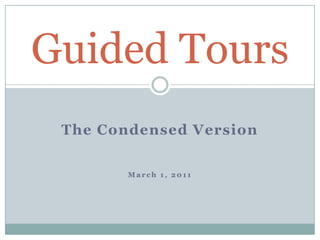
Museum guided tours
- 1. The Condensed Version March 1, 2011 Guided Tours
- 2. Basic layout of a guided tour Defined objectives Introduction Content Conclusion Evaluation of learning
- 3. Objectives Content you intend the audience to learn Examples: The visitor will be able to identify the historical progression of basketball Students will be able to identify the cultural affect of Penn State’s 1947 Cotton Bowl team Visitors will be able to recognize artwork from the Impressionistic period. Students will be able to identify sculpture based on its medium.
- 4. Learning Goals How you will accomplish and measure your objectives Examples: The visitor will be able to identify the historical progression of basketball Discuss Dr. Naismith, and his intention with inventing basketball. Explain the roots of the name basket-ball. Show antique replica of a 1920’s basketball and talk about what “dribbling” originally looked like. Discuss women’s role in basketball, and how the game was first played by women. Etc
- 5. Learning Goals Examples: The visitor will be able to identify the historical progression of basketball Apply PA State Standards for History: 8.3.12.A Identify and evaluate the political and cultural contributions of individuals and groups to the United States history from 1890-present Cultural and commercial leaders 8.3.12.C Evaluate how continuity and change has influenced United States history from 1890-present Innovations Social organization Women’s movement
- 6. Learning Goals Students will be able to understand and identify sculptures based on its medium. Show 3 mediums; clay, metal, and wood. Talk about the similarities and differences between the 3, i.e. how they are made, how valuable they might be, etc. Use hands on materials to feel the differences between the 3 and describe other things that are made out of those materials. Continue throughout the museum seeking to identify other artwork made out of the materials they’ve been learning about.
- 7. Learning Goals Students will be able to understand and identify sculptures based on its medium. PA State Standards for Arts and Humanities: 9.3.3.C Know classification skills with materials and processes used to create works in the arts. 9.3.3.F Know how to recognize and identify similar and different characteristics among works of art.
- 8. Introduction Introduce the institution, its history, mission, and a brief overview of the museums exhibits/collections. Introduce yourself Find out something about your visitors Let visitors know your plan Point out important areas (restroom, water fountain, etc) Cover basic museum rules
- 9. Interpretive Techniques Lecture Lecture Discussion Inquiry Discussion Guided Discovery Guided Involvement Random
- 10. Interpretive Techniques Lecture technique: How the majority of your collegiate professors conduct class.
- 11. Interpretive Techniques Lecture Discussion Technique: Similar to lecture technique, but now welcomes questions and visitor participation in discussions. Ideal for adult groups, good college aged groups, and acceptable for older adolescent groups.
- 12. Interpretive Techniques Inquiry Discussion Technique: Tour is set up as more of a dialog, consisting of questions, exchanging of answers, and discussion between guides and visitors. Visitors explore ideas with guidance and direction of a guide. Guides function as more of a discussion leader, rather than a lecturer. Specific facts are less important than the general context, time period, culture, etc. Appropriate for any age group.
- 13. Interpretive Techniques Guided Discovery Technique: Offers visitors a structured activity that requires them to make individual choices on what they wish to learn within the exhibits. Best for children older than 7yrs old, through adults.
- 14. Interpretive Techniques Guided Involvement Technique: Similar to Guided Discovery, but its highly structured . Visitors/students are given a task, often will work together in small groups with direct supervision. Each activity occurs over short periods of time and within limited areas.
- 15. Interpretive Techniques Random: Self-guided walk through of the museum with a guide present. Often used when visitors come to a museum and request a guided walk-through (if a museum is capable and able to provide it), when very large groups request a tour, or when groups become difficult and frustrated guides walk with them to keep them together and move them out of the exhibits and museum in an orderly fashion.
- 16. Questioning Strategies Memory Convergent Divergent Judgmental
- 17. Questioning Strategies Memory Facts, names, dates, etc. “how many…” “what is the…” “name the…”
- 18. Questioning Strategies Convergent questions Seek the most appropriate/best answer There is one best answer
- 19. Questioning Strategies Divergent questions Open-ended questions that encourage multiple answers. Questions demand imaginative thinking and exploration of all possibilities. There is no “right” answer “what if…” “how many ways…” “imagine that…”
- 20. Questioning Strategies Judgmental questions Encourages each visitor to formulate an opinion, value, or belief that is personal to them.
- 21. Questioning Strategies Levels of questions Naming objects Discriminating characteristics of objects and events Classifying and grouping objects and events Making inferences Drawing conclusions based on observations, forming a hypotheses, making a logical judgments, etc. Evaluation and Judgment Choose, decide, evaluate, judge, assess, give your opinion, tell which is preferable, etc.
- 22. Tour Aids Games Improvisation Hands-on materials Project-directed and data retrieval Storytelling Audio-visual aids Films Interactive exhibits
- 23. Introduction
- 24. Conclusion Review/give a summary what was seen or done Ask their most enjoyable part of the tour, what they remember the most, etc. Encourage visitors to return. Cite future programming/events at the museum. Self-evaluate. Did you accomplish your objectives?
- 25. Evaluation What are the basic contents of a guided tour? What are learning goals? What do you include in an introduction? Name some interpretive techniques. Name some questioning strategies. What do you include in a conclusion?
